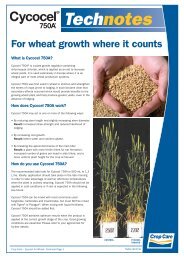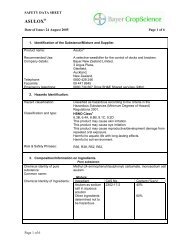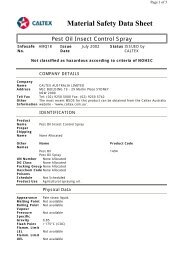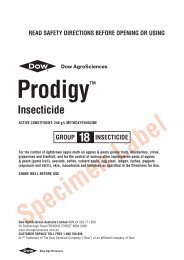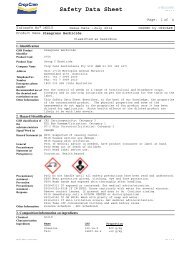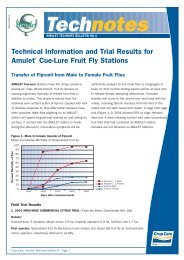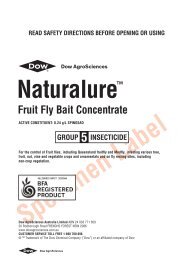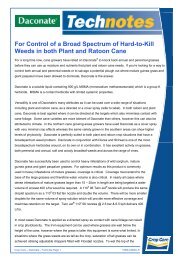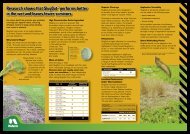Fastac Duo Technical Manual - Pest Genie
Fastac Duo Technical Manual - Pest Genie
Fastac Duo Technical Manual - Pest Genie
You also want an ePaper? Increase the reach of your titles
YUMPU automatically turns print PDFs into web optimized ePapers that Google loves.
Environmentally the best<br />
insecticide we have ever made...<br />
An Overv i e w<br />
FASTAC <strong>Duo</strong> is a highly active synthetic pyrethroid<br />
insecticide used at relatively low rates of<br />
application. At these rates, FASTAC <strong>Duo</strong> controls a<br />
wide range of pests on most of the world’s<br />
economically important crops.<br />
Note: Reference is made to the original FASTAC ®<br />
100 EC formulation in these environmental<br />
studies. The same conclusions apply to FASTAC<br />
<strong>Duo</strong>; so to avoid confusion FA S TAC <strong>Duo</strong> is<br />
referred to in this section.<br />
It is known that FASTAC <strong>Duo</strong> and compounds<br />
related to it are not hazardous to birds and<br />
mammals when used as recommended. However,<br />
their high level of biological activity suggest that<br />
they might put at risk non-target species such as<br />
honey bees, insect predators and fish in<br />
waterways near farms. A series of extensive<br />
studies was set up, several of them unique, to<br />
investigate the behaviour of FA S TAC <strong>Duo</strong> in<br />
relation to the environment. These studies<br />
demonstrated that, despite its high level of<br />
activity against pests, FASTAC <strong>Duo</strong>, when used as<br />
recommended generally has little effect on nontarget<br />
species.<br />
Despite toxicity to bees in the laboratory -<br />
extensive field tests have established that <strong>Fastac</strong><br />
<strong>Duo</strong> has no adverse effects either short or long<br />
term when used under field conditions. This is<br />
because of the very low rates FASTAC <strong>Duo</strong> is used<br />
at in field applications, and by the fact that freshly<br />
sprayed FASTAC <strong>Duo</strong> deposits repel bees so they<br />
quickly move away from the area being sprayed.<br />
Similarly, FASTAC <strong>Duo</strong> is toxic to fish in laboratory<br />
test but has been shown to have no significant<br />
effect on them in natural water. This is again partly<br />
because of very low dose rates but also because of<br />
the unusual physico-chemico properties of<br />
FASTAC <strong>Duo</strong>. Combined, these factors prevent all<br />
but extremely low concentrations of FASTAC <strong>Duo</strong><br />
passing into the sub-surface water.<br />
Environmental studies have also shown that at the<br />
rates used for insect pest control in crops, FASTAC<br />
<strong>Duo</strong> has less effect on beneficial insects like<br />
chalcid wasps than many other widely used<br />
insecticides.<br />
These studies have demonstrated that<br />
despite the high intrinsic level of activity of<br />
FA S TAC <strong>Duo</strong>, it has a minimal effect on<br />
non-target species under practical<br />
conditions of use. FA S TAC <strong>Duo</strong> therefore<br />
o ffers a definite advance in insecticides<br />
suitable for both conventional pest control<br />
and pest management systems.<br />
Beneficial arthropods such as dragonflies, spiders<br />
and hymenopterous parasites, show only transient<br />
or no effects from exposure to FA S TA CD u o.<br />
Honey Bees<br />
For the farm e r, foraging honey bees pollinate his<br />
crops; for the bee keeper, large areas of crops like<br />
canola dramatically increase his honey production.<br />
But if the crop is attacked by pests during the<br />
flowering period the farmer needs to spray. Because<br />
FA S TAC <strong>Duo</strong> can be used to control many pests of<br />
flowering crops, considerable eff o rt has been put<br />
into establishing its safety to honey bees. A<br />
sequence of detailed experiments were carried out,<br />
beginning with simple laboratory tests and<br />
progressing stage by stage to large-scale field trials<br />
to prove this.<br />
FA S TAC <strong>Duo</strong> is known to have a deterrent<br />
e ffect on foraging bees for a short period<br />
of time after spraying. Risk to bees is<br />
reduced by spraying in early morning and<br />
late evening while bees are not foraging.<br />
4



